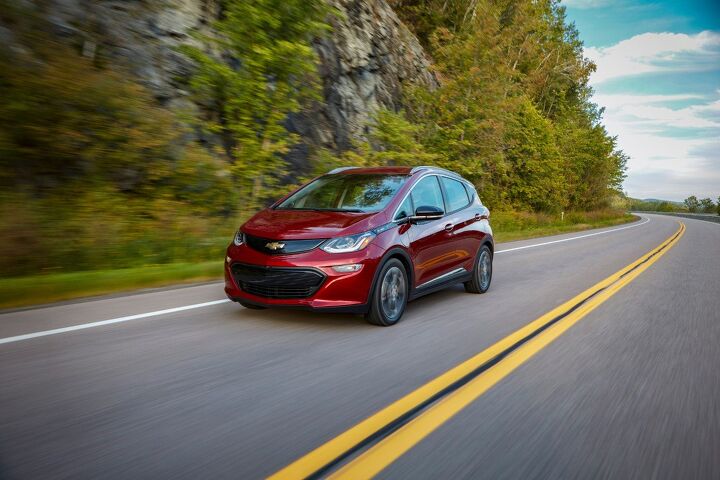Will Your EV's Range Suffer in the Cold? Norway Sheds Some Light on That

Obviously, cold winter weather will have some impact on how far you can drive in your electric vehicle, but just how much range loss you can expect depends on make and model and, of course, the actual temperature. Your own comfort levels will dictate heater and seat warmer settings, potentially shaving off more miles.
After the TTAC budget for a comprehensive multi-model test turned up a squirrel and two paper clips, the Norwegian Automobile Federation stepped in, putting a raft of new models through their paces.
If you’ve ever seen the Norwegian film In Order of Disappearance, a black comedy revolving around a vengeful snowplow operator, you’ll know that Norway gets pretty cold and snowy. There’s also no shortage of EVs. It’s an electrified mecca over there, so what better locale for a range test?
Published in the federation’s Motor magazine, the results show that even mild winter weather may require alterations to travel planning. As the test cars plied their way north from the capital of Oslo, temps fell from just above freezing to minus 6 degrees Celsius. That’s 21F, or shorts weather in Minneapolis.
Each vehicle embarked with a fully charged cold battery, with the cabin temperature set to room temp and the seat warmers on low (these being the most likely real-world settings). Every vehicle was then driven until battery exhaustion.
The findings? Let’s start with the biggest winner and greatest loser. In terms of range retention, the Hyundai Kona Electric shed the least miles, retaining 90 percent of its WLTP range. The Opel Ampera-e, known to Americans as the Chevrolet Bolt, saw the greatest loss. The little hatch retained only 70 percent of its range, whining to a halt after 184.5 miles.
The rest of the pack saw range retention mainly in the high 70-percent realm, though the big-battery Tesla Model 3 was fairly low on the scale with 72 percent retention. The Jaguar I-Pace ranked a hair lower, at 71 percent. Of course, both of these models, like the Ampera-e/Bolt and Kona, have range to spare in most driving applications.
Two models at opposite ends of the price ladder returned good range retention. These vehicles were the Tesla Model X, which kept 83 percent of its WLTP range during the test, and the lowly Hyundai Ioniq Electric, which kept 87 percent. Despite getting a range boost for 2020, the Ioniq needs to keep all the miles it can.
Indeed, the importance of range retention increases as rated range drops. A driving radius that might be deemed adequate for a buyer’s purposes on a warm, sunny day in June might not be quite as rosy in January. Hardly a concern to, say, Californians, but it’s certainly something worth considering if you live in Chicago or Toronto. Keep in mind that the testing conditions in Norway were fairly mild.
No one wants to forego heat in a bid to make it to their destination.
One model that was supposed to reach our shores in short order (but has since been delayed a full year) is the Mercedes-Benz EQC, which generated some controversy when the automaker announced a lackluster estimated EPA range of 200 miles. The company soon increased that projection to 222 miles. In the Norwegian test, the driver made it 190 miles before requiring a tow to the nearest fast-charge station.
Sadly, there was no Porsche Taycan to test. That models boasts a range that pales in comparison to even Chevrolet and Hyundai.
As for the commonplace Nissan Leaf and Leaf Plus, those models retained 77 and 78 percent of their range, respectively. The most affordable of those two is rated at 151 miles by the EPA. The Norwegian test returned 129.9 miles.
One test only provides us with an idea of what to expect. A multitude of factors come into play when it comes to EV range: temperature, whether or not the vehicle contains a battery heater (or whether the garage itself is heated), terrain, and use of vehicle accessories. Still, it’s just another reminder to do your homework before buying a new vehicle.
[Image: Hyundai, General Motors]

More by Steph Willems
Latest Car Reviews
Read moreLatest Product Reviews
Read moreRecent Comments
- 3-On-The-Tree My 2009 C6 corvette in black looks great when it’s all washed and waxed but after driving down my 1.3 mile long dirt road it’s a dust magnet. I like white because dust doesn’t how up easily. Both my current 2021 Tundra and previous 2014 Ford F-150 3.5L Ecobomb are white
- Bd2 Would be sweet on a Telluride.
- Luke42 When will they release a Gladiator 4xe?I don’t care what color it is, but I do care about being able to plug it in.
- Bd2 As I have posited here numerous times; the Hyundai Pony Coupe of 1974 was the most influential sports and, later on, supercar template. This Toyota is a prime example of Hyundai's primal influence upon the design industry. Just look at the years, 1976 > 1974, so the numbers bear Hyundai out and this Toyota is the copy.
- MaintenanceCosts Two of my four cars currently have tires that have remaining tread life but 2017 date codes. Time for a tire-stravaganza pretty soon.



































Comments
Join the conversation
My wife, who is cold all the time doesn't even leave the seat heat on once the leather is up to body temp. Do people really leave the heated seats on all the time? I guess the question might be, do heated seats take less power than heating the cabin so you can heat your backside and lower the cabin temp?
I hit "reply", write all that, and then you tell me I need to log in? Again? You basta...! At least with the old commenting system you could go back and retrieve your text.